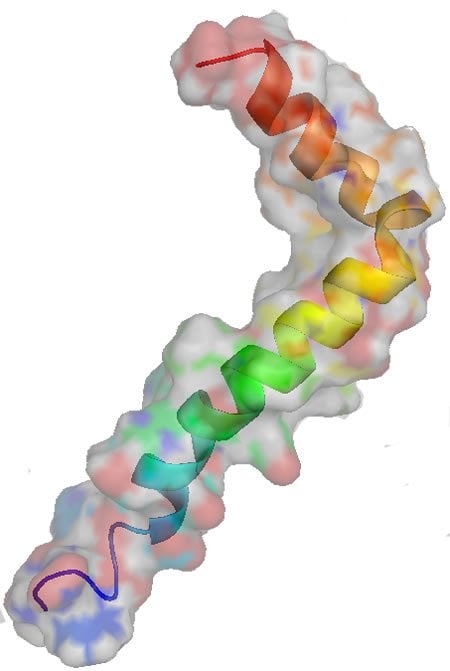A new study from Karolinska Institutet shows that amyloid-β-peptides, which are thought to be toxic and a suspected cause of Alzheimer’s disease, actually have a biological function. The discovery, which is published in the journal Brain, can help to explain why the so-called cholinergic signal systems are the first to be damaged on the onset of the disease.
Research on amyloid-β-peptides in Alzheimer’s disease has mainly been based on their presumed toxicity and causal role in the development of the disease. At the early stages of development, Alzheimer’s disease particularly affects cholinergic signalling via the neurotransmitter acetylcholine, but why this is the case is still unknown.
The present study indicates that amyloid-β has a physiological function and influences the balance of acetylcholine in the brain. What the researchers have discovered is that amyloid-β forms particular complexes that they call BAβAC (BChE/AChE/Aβ/ApoE complex). The complexes contain two different enzymes that break down acetylcholine at the synapses between nerve cells or between nerve cells and glial cells.

“When amyloid-β binds to them, the enzymes become hyperactive, and the neurotransmitter acetylcholine breaks down more rapidly,” says principal investigator, Dr Taher Darreh-Shori at Karolinska Institutet’s Department of Neurobiology, Care Sciences and Society. “This could, in turn, change the functional status of the brain’s neuroglial cells, such as astrocytes and oligodendrocytes.”
Surprised the team
Another find, which surprised the team, concerns apolipoprotein-e4 (ApoE4), which is the best confirmed genetic risk factor for Alzheimer’s. It is not known how ApoE increases the risk of disease, but previous research has linked ApoE to the accumulation of amyloid-β plaque in the brains of Alzheimer’s patients.
“Our results show that ApoE keeps amyloid-β soluble in the form of amyloid-ApoE complexes, which leads to the accumulation of reactive BAβA complexes,” says Dr Darreh-Shori. “High levels of ApoE seem to have a pathological effect on this mechanism, which could cause the cholinergic nerve pathways characteristic of Alzheimer’s to degrade.”
He and his co-researchers will now study whether the BAβA complexes differ between the brains of Alzheimer’s patients and healthy people, and if it is possible to cancel their effect.
Funding: The study was financed by grants from several bodies, including the Åhlén Foundation, the Dementia Foundation of the Swedish Dementia Association, the Olle Engkvist Foundation and the Åke Wiberg Foundation.
Source: Katarina Sternudd – Karolinska Institute
Image Credit: The image is credited to Boku wa Kage and is licensed CC BY-SA 3.0
Original Research: Full open access research for “Amyloid-β peptides act as allosteric modulator of cholinergic signaling through formation of soluble BaβACs” by Rajnish Kumar; Agneta Nordberg, and Taher Darreh-Shori in Brain. Published online November 2 2015 doi:10.1093/brain/awv318 awv318
Abstract
Amyloid-β peptides act as allosteric modulator of cholinergic signaling through formation of soluble BaβACs
Amyloid-β peptides, through highly sophisticated enzymatic machinery, are universally produced and released in an action potential synchronized manner into the interstitial fluids in the brain. Yet no native functions are attributed to amyloid-β. The amyloid-β hypothesis ascribes just neurotoxicity properties through build-up of soluble homomeric amyloid-β oligomers or fibrillar deposits. Apolipoprotein-ε4 (APOE4) allele is the only confirmed genetic risk factor of sporadic Alzheimer’s disease; once more it is unclear how it increases the risk of Alzheimer’s disease. Similarly, central cholinergic signalling is affected selectively and early in the Alzheimer’s disease brain, again why cholinergic neurons show this sensitivity is still unclear. However, the three main known Alzheimer’s disease risk factors, advancing age, female gender and APOE4, have been linked to a high apolipoprotein-E and accumulation of the acetylcholine degrading enzyme, butyrylcholinesterase in cerebrospinal fluids of patients. Furthermore, numerous reports indicate that amyloid-β interacts with butyrylcholinesterase and apolipoprotein-E. We have proposed that this interaction leads to formation of soluble ultrareactive acetylcholine-hydrolyzing complexes termed BAβACs, to adjust at demand both synaptic and extracellular acetylcholine signalling. This hypothesis predicted presence of acetylcholine-synthesizing enzyme, choline acetyltransferase in extracellular fluids to allow maintenance of equilibrium between breakdown and synthesis of acetylcholine through continuous in situ syntheses. A recent proof-of-concept study led to the discovery of this enzyme in the human extracellular fluids. We report here that apolipoprotein-E, in particular ε4 isoprotein acts as one of the strongest endogenous anti-amyloid-β fibrillization agents reported in the literature. At biological concentrations, apolipoprotein-E prevented amyloid-β fibrillization for at least 65 h. We show that amyloid-β interacts readily in an apolipoprotein-facilitated manner with butyrylcholinesterase, forming highly stable and soluble complexes, BAβACs, which can be separated in their native states by sucrose density gradient technique. Enzymological analyses further evinced that amyloid-β concentration dependently increased the acetylcholine-hydrolyzing capacity of cholinesterases. In silico biomolecular analysis further deciphered the allosteric amino acid fingerprint of the amyloid-β-cholinesterase molecular interaction in formation of BAβACs. In the case of butyrylcholinesterase, the results indicated that amyloid-β interacts with a putative activation site at the mouth of its catalytic tunnel, most likely leading to increased acetylcholine influx into the catalytic site, and thereby increasing the intrinsic catalytic rate of butyrylcholinesterase. In conclusion, at least one of the native physiological functions of amyloid-β is allosteric modulation of the intrinsic catalytic efficiency of cholinesterases, and thereby regulation of synaptic and extrasynaptic cholinergic signalling. High apolipoprotein-E may pathologically alter the biodynamics of this amyloid-β function.
“Amyloid-β peptides act as allosteric modulator of cholinergic signaling through formation of soluble BaβACs” by Rajnish Kumar; Agneta Nordberg, and Taher Darreh-Shori in Brain. Published online November 2 2015 doi:10.1093/brain/awv318 awv318






